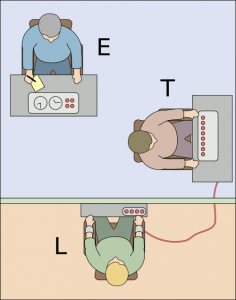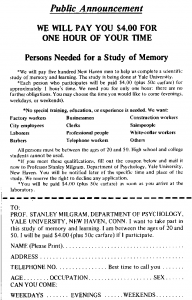There have been such gems amongst us, who changed the course of the world, because they could look at the world differently. Their thinking was unique and not everyone understood them. They were opposed, yet they emerged winners and the world was amazed.
Fakta Baru Di Dunia
Ada 3 fakta baru yang ditemukan di dunia ini:
Fakta #1:
Kamu tidak akan bisa menyentuh semua gigimu dengan menggunakan lidahmu.
Fakta #2:
Setelah membaca Fakta #1, dengan bodohnya kamu akan mempraktekannya.
Fakta #3:
Setelah membaca Fakta #2, kamu akan tersenyum dengan jengkelnya.
Berapa Lama Nama Anda Bisa Diingat?
Film yang ditayangkan pada malam itu sepertinya berjudul Bridge produk Yugoslavia. Dia sedang berjalan akan memasuki gedung bioskop, tiba-tiba datang seorang anak muda mencegatnya. Anak muda ini kelihatannya sangat tergesa-gesa, dia berkata, “Kakak, maukah Anda menjual karcis bioskop Anda kepada saya? Karena tiket di loket telah habis terjual.” Dia tercengang dan agak berkeberatan.
Melihat keadaan ini, raut wajah si pemuda menjadi murung, dia melanjutkan berkata, “Kami datang dari desa, saya berkeinginan mengajak ibu saya menonton film.”
Oleh karena hati pemuda ini terlihat sangat berbakti pada kedua orang tuanya, maka dia akhirnya dengan ikhlas telah menyumbangkan tiket bioskopnya kepada pemuda itu, diberikan gratis. Pemuda itu selain mengucapkan beribu-ribu terima kasih kepadanya, juga dengan serius telah menanyakan namanya.
Ini merupakan suatu pemandangan yang sangat biasa di dalam kehidupan masyarakat yang sangat sibuk dan ramai. Puluhan tahun telah berlalu, peristiwa tersebut sudah hampir dia lupakan. Pada suatu hari, ketika dia sedang berjalan, tiba-tiba terdengar seseorang memanggil namanya dengan perlahan-lahan. Dia melihat seseorang paruh baya dengan muka penuh seyuman sedang berdiri di depannya.
Orang paruh baya itu berkata, “Kakak, apakah Anda masih ingat dengan tiket film yang Anda berikan kepada saya puluhan tahun yang lalu?”
“Ketika itu saya datang dari desa, menemani ibu saya untuk berobat. Ibu saya sedang sakit keras, karena saya takut ibu tidak ada harapan setelah dari operasi, maka saya ingin mengajak dia untuk menonton film.”
“Hari itu, sudah banyak orang yang menolak permohonan saya. Hanya Anda, dengan belas kasih mau memberikan tiket itu kepada saya.”
“Tahukah Anda, setelah operasi, ibu saya bisa memperpanjang hidupnya selama satu tahun. Dalam satu tahun itu, setiap kali ketika dia dengan bahagia mengatakan kalimat “Saya pernah nonton film di kota”, dengan penuh rasa berterima kasih di dalam hati saya berulang-ulang menyebutkan nama Anda.”
“Ya begitulah Kak, sudah bertahun-tahun, saya selalu tak bisa melupakan.”
Ini adalah kisah yang diceritakan oleh ayah teman saya kepada kami di dalam suatu jamuan makan.
Kali itu, dengan nada agak mengeluh dengan sayu dia berkata, “Saya hanya melakukan hal yang demikian kecil, namun telah membuat seseorang yang belum pernah saya kenal sebelumnya mengingat nama saya, selama bertahun-tahun.”
“Sebenarnya, sesaat ketika dia memanggil nama saya, saya masih merasakan semacam kebahagiaan yang tidak dapat diutarakan. Yang saya maksud adalah, perjalanan hidup kalian di kemudian hari masih sangat panjang, berapa lamakah Anda bisa membuat benak orang lain mengingat nama Anda?”
Sepatah kata yang mengejutkan hati. Memang betul, di dalam dunia ini terdapat banyak sekali nama orang yang sirna tertiup oleh angin dari perjalanan waktu, dan nama-nama lain, karena kasih pengorbanan dan pemberian dari kasih, telah menjadi monumen yang tak tergoyahkan di dalam terpaan angin.
Sumber: The Epoch Times – Christine Lin
Kenapa Ayam Menyebrang Jalan?
Kenapa Ayam Menyebrang Jalan?
Guru TK:
Supaya sampai ke ujung jalan.
FBI:
Beri saya lima menit dengan ayam itu, saya akan tahu kenapa.
Aristoteles:
Karena merupakan sifat alami dari ayam.
Martin Luther King, Jr.:
Saya memimpikan suatu dunia yang membebaskan semua ayam menyeberang jalan tanpa mempertanyakan kenapa. (I dream of a world where chickens can cross the road and not be questioned about their motives. – Ralph Waldo Emerson-)
Milgram Experiment – Will People Do Anything If Ordered?

The Milgram experiment on obedience to authority figures was a series of social psychology experiments conducted by Yale University psychologist Stanley Milgram. They measured the willingness of study participants to obey an authority figure who instructed them to perform acts conflicting with their personal conscience. Milgram first described his research in 1963 in an article published in the Journal of Abnormal and Social Psychology and later discussed his findings in greater depth in his 1974 book, Obedience to Authority: An Experimental View.
The experiments began in July 1961, in the basement of Linsly-Chittenden Hall at Yale University, three months after the start of the trial of German Nazi war criminal Adolf Eichmann in Jerusalem. Milgram devised his psychological study to answer the popular question at that particular time: “Could it be that Eichmann and his million accomplices in the Holocaust were just following orders? Could we call them all accomplices?” The experiments have been repeated many times in the following years with consistent results within differing societies, although not with the same percentages around the globe.
The experiment

Three individuals were involved: the one running the experiment, the subject of the experiment (a volunteer), and a confederate pretending to be a volunteer. These three people fill three distinct roles: the Experimenter (an authoritative role), the Teacher (a role intended to obey the orders of the Experimenter), and the Learner (the recipient of stimulus from the Teacher). The subject and the actor both drew slips of paper to determine their roles, but unknown to the subject, both slips said “teacher”. The actor would always claim to have drawn the slip that read “learner”, thus guaranteeing that the subject would always be the “teacher”. At this point, the “teacher” and “learner” were separated into different rooms where they could communicate but not see each other. In one version of the experiment, the confederate was sure to mention to the participant that he had a heart condition.
At some point prior to the actual test, the “teacher” was given a sample electric shock from the electroshock generator in order to experience firsthand what the shock that the “learner” would supposedly receive during the experiment would feel like. The “teacher” was then given a list of word pairs that he was to teach the learner. The teacher began by reading the list of word pairs to the learner. The teacher would then read the first word of each pair and read four possible answers. The learner would press a button to indicate his response. If the answer was incorrect, the teacher would administer a shock to the learner, with the voltage increasing in 15-volt increments for each wrong answer. If correct, the teacher would read the next word pair.
The subjects believed that for each wrong answer, the learner was receiving actual shocks. In reality, there were no shocks. After the confederate was separated from the subject, the confederate set up a tape recorder integrated with the electroshock generator, which played prerecorded sounds for each shock level. After a number of voltage-level increases, the actor started to bang on the wall that separated him from the subject. After several times banging on the wall and complaining about his heart condition, all responses by the learner would cease.
At this point, many people indicated their desire to stop the experiment and check on the learner. Some test subjects paused at 135 volts and began to question the purpose of the experiment. Most continued after being assured that they would not be held responsible. A few subjects began to laugh nervously or exhibit other signs of extreme stress once they heard the screams of pain coming from the learner.
If at any time the subject indicated his desire to halt the experiment, he was given a succession of verbal prods by the experimenter, in this order:
- Please continue.
- The experiment requires that you continue.
- It is absolutely essential that you continue.
- You have no other choice, you must go on.
If the subject still wished to stop after all four successive verbal prods, the experiment was halted. Otherwise, it was halted after the subject had given the maximum 450-volt shock three times in succession.
The experimenter also gave special prods if the teacher made specific comments. If the teacher asked whether the learner might suffer permanent physical harm, the experimenter replied, “Although the shocks may be painful, there is no permanent tissue damage, so please go on.” If the teacher said that the learner clearly wants to stop, the experimenter replied, “Whether the learner likes it or not, you must go on until he has learned all the word pairs correctly, so please go on.”
Results
Before conducting the experiment, Milgram polled fourteen Yale University senior-year psychology majors to predict the behavior of 100 hypothetical teachers. All of the poll respondents believed that only a very small fraction of teachers (the range was from zero to 3 out of 100, with an average of 1.2) would be prepared to inflict the maximum voltage. Milgram also informally polled his colleagues and found that they, too, believed very few subjects would progress beyond a very strong shock. Milgram also polled forty psychiatrists from a medical school, and they believed that by the tenth shock, when the victim demands to be free, most subjects would stop the experiment. They predicted that by the 300-volt shock, when the victim refuses to answer, only 3.73 percent of the subjects would still continue and, they believed that “only a little over one-tenth of one percent of the subjects would administer the highest shock on the board.”
In Milgram’s first set of experiments, 65 percent (26 of 40) of experiment participants administered the experiment’s final massive 450-volt shock, though many were very uncomfortable doing so; at some point, every participant paused and questioned the experiment; some said they would refund the money they were paid for participating in the experiment. Throughout the experiment, subjects displayed varying degrees of tension and stress. Subjects were sweating, trembling, stuttering, biting their lips, groaning, digging their fingernails into their skin, and some were even having nervous laughing fits or seizures.
Milgram summarized the experiment in his 1974 article, “The Perils of Obedience”, writing:
The legal and philosophic aspects of obedience are of enormous importance, but they say very little about how most people behave in concrete situations. I set up a simple experiment at Yale University to test how much pain an ordinary citizen would inflict on another person simply because he was ordered to by an experimental scientist. Stark authority was pitted against the subjects’ [participants’] strongest moral imperatives against hurting others, and, with the subjects’ [participants’] ears ringing with the screams of the victims, authority won more often than not. The extreme willingness of adults to go to almost any lengths on the command of an authority constitutes the chief finding of the study and the fact most urgently demanding explanation.
Ordinary people, simply doing their jobs, and without any particular hostility on their part, can become agents in a terrible destructive process. Moreover, even when the destructive effects of their work become patently clear, and they are asked to carry out actions incompatible with fundamental standards of morality, relatively few people have the resources needed to resist authority.
The original Simulated Shock Generator and Event Recorder, or shock box, is located in the Archives of the History of American Psychology.
Later, Milgram and other psychologists performed variations of the experiment throughout the world, with similar results. Milgram later investigated the effect of the experiment’s locale on obedience levels by holding an experiment in an unregistered, backstreet office in a bustling city, as opposed to at Yale, a respectable university. The level of obedience, “although somewhat reduced, was not significantly lower.” What made more of a difference was the proximity of the “learner” and the experimenter. There were also variations tested involving groups.
Thomas Blass of the University of Maryland, Baltimore County performed a meta-analysis on the results of repeated performances of the experiment. He found that while the percentage of participants who are prepared to inflict fatal voltages ranged from 28% to 91%, there was no significant trend over time and the average percentage for US studies (61%) was close to the one for non-US studies (66%).
The participants who refused to administer the final shocks neither insisted that the experiment itself be terminated, nor left the room to check the health of the victim without requesting permission to leave, as per Milgram’s notes and recollections, when fellow psychologist Philip Zimbardo asked him about that point.
Milgram created a documentary film titled Obedience showing the experiment and its results. He also produced a series of five social psychology films, some of which dealt with his experiments.
Interpretations
Professor Milgram elaborated two theories:
- The first is the theory of conformism, based on Solomon Asch conformity experiments, describing the fundamental relationship between the group of reference and the individual person. A subject who has neither ability nor expertise to make decisions, especially in a crisis, will leave decision making to the group and its hierarchy. The group is the person’s behavioral model.
- The second is the agentic state theory, wherein, per Milgram, “the essence of obedience consists in the fact that a person comes to view themselves as the instrument for carrying out another person’s wishes, and they therefore no longer see themselves as responsible for their actions. Once this critical shift of viewpoint has occurred in the person, all of the essential features of obedience follow”.
Alternative interpretations
In his book Irrational Exuberance, Yale Finance Professor Robert Shiller argues that other factors might be partially able to explain the Milgram Experiments:
[People] have learned that when experts tell them something is all right, it probably is, even if it does not seem so. (In fact, it is worth noting that in this case the experimenter was indeed correct: it was all right to continue giving the “shocks”—even though most of the subjects did not suspect the reason.)
In a 2006 experiment, a computerized avatar was used in place of the learner receiving electrical shocks. Although the participants administering the shocks were aware that the learner was unreal, the experimenters reported that participants responded to the situation physiologically “as if it were real”.
For a 2009 episode of the BBC science documentary series Horizon, the Milgram experiment was replicated. Of the twelve participants, only three refused to continue to the end of the experiment. Speaking during the episode, social psychologist Clifford Stott discussed the influence that the idealism of scientific inquiry had on the volunteers. He remarked: “The influence is ideological. It’s about what they believe science to be, that science is a positive product, it produces beneficial findings and knowledge to society that are helpful for society. So there’s that sense of science is providing some kind of system for good.”
Ibu Yang Bijak
Seorang anak bertanya kepada Mamanya, “Ma, mama temanku membiarkan nyamuk menggigit tangannya sampai kenyang agar tidak menggigit anaknya. Apakah Mama juga akan melakukan hal yg sama?”
Si Mama tertawa, “Tidak. Tetapi Mama akan mengejar setiap nyamuk sepanjang malam agar tidak sempat menggigit siapapun.”
“Oh iya. Kubaca tentang seorang mama yang rela tidak makan agar anak-anaknya bisa makan kenyang. Akankah Mama melakukan hal yg sama?”, si anak kembali bertanya.
Dengan tegas Mamanya menjawab, Mama akan bekerja keras agar kita semua bisa makan kenyang dan kamu tidak harus sulit menelan karena melihat Mama menahan lapar.
Si anak tersenyum, “Aku bisa selalu bersandar padamu Mama.”
Si Ibu kemudian berkata, “Tidak Nak! Mama akan mengajarmu berdiri kokoh di atas kakimu sendiri agar tidak harus jatuh tersungkur ketika suatu saat nanti Mama harus pergi meninggalkanmu.”
Penerapan:
Seorang Mama yang bijak bukan hanya menjadikan dirinya tempat bersandar tetapi juga bisa membuat sandaran tersebut tidak lagi diperlukan.
Wason Selection Task

Original Question:
Each card has a number on one side, and a patch of color on the other. Which card(s) must be turned over to test the idea that if a card shows an even number on one face, then its opposite face is red?
Question in Bahasa Indonesia:
Gambar di atas adalah 4 kartu yang masing-masing memiliki sisi huruf dan sisi angka. Jadi, dibalik kartu “3” dan “8” tertulis suatu huruf dan dibalik kartu “Merah” dan “Coklat” tertulis suatu angka. Anda harus membuka 2 kartu untuk memeriksa kebenaran dari pernyataan, “Jika sebuah kartu menunjukkan nilai genap di satu sisi, maka sisi sebaliknya adalah warna merah.”. Kartu manakah yang harus Anda buka?
Note:
The Wason selection task (or four-card problem) is a logic puzzle devised by Peter Cathcart Wason in 1966. It is one of the most famous tasks in the study of deductive reasoning.
Untuk menjawab pertanyaan diatas akan lebih mudah jika kita memberikan konteks. Coba jawab pertanyaan di bawah ini:
Di sebuah bar terdapat 4 orang yang sedang minum.
Orang 1: Minum alkohol.
Orang 2: Minum non-alkohol.
Orang 3: Berumur 30 tahun.
Orang 4: Berumur 19 tahun.
Di dalam bar tersebut terdapat peraturan, “Semua yang minum alkohol harus berumur di atas 21 tahun.”.
Untuk memerika apakah aturan di atas ditaati, orang nomor berapa saja yang harus diperiksa? (Untuk Orang 1 dan Orang 2, kita harus memeriksa KTP-nya. Untuk Orang 3 dan Orang 4 kita periksa minumannya.)
The correct response is to turn over the 8 and the brown cards.
The rule was “If the card shows an even number on one face, then its opposite face is red.” Only a card with both an even number on one face and something other than red on the other face can invalidate this rule:
1. If the 3 card is red (or brown), that doesn’t violate the rule.
2. If the 8 card is brown, that violates the rule.
3. If the red card is odd (or even), that doesn’t violate the rule. Because it doesn’t necessarily mean that red card should only be facing an even number. Its only that an even number should be facing red but vice versa is not mandatory. As nothing is mentioned about odd numbers, even the odd numbers might be facing red. But its only that even numbers must be facing red.
4. If the brown card is even, that violates the rule.
Use of logic
The interpretation of “if” here is that of the material conditional in classical logic, so this problem can be solved by choosing the cards using modus ponens (all even cards must be checked to ensure they are red) and modus tollens (all non-red cards must be checked to ensure they are non-even).
Macbeth
Macbeth adalah seorang jendral di bawah pemerintahan raja Skotlandia Duncan I. Pada suatu hari ia dan temannya Banquo bertemu dengan tiga tukang sihir yang meramalkan bahwa Macbeth bakal menjadi raja suatu hari, dan Banquo walaupun tidak akan menjadi raja tapi akan memperanakkan raja-raja.
Ketika Macbeth pulang dan memberitakan hal ini kepada istrinya Lady Macbeth, ia segera menyusun rencana untuk membunuh Duncan yang akan berkunjung dan menginap di rumah mereka. Setelah menjadi raja, Macbeth juga takut bahwa Banquo akan membocorkan rahasia tentang ketiga tukang sihir, dan memerintahkan ia dibunuh juga.
Sementara itu seorang jendral lain yang bernama Macduff menjadi curiga akan tingkah laku Macbeth yang menampakkan gejala-gejala ketakutan dan rasa bersalah. Ia kemudian bergabung dengan Malcolm dan Donalbain, kedua anak Duncan yang juga merasa curiga.
Perasaan takut Macbeth mendorongnya untuk mencari tukang-tukang sihir itu lagi, dan kali ini mereka meramalkan bahwa Macbeth akan tetap hidup “sampai hutan Great Birnam datang ke bukit Dunsinane”. Selain itu, juga bahwa Macbeth tidak akan dibunuh oleh seorang yang dilahirkan dari seorang wanita. Berpikir bahwa ini hal yang mustahil, Macbeth menjadi sombong dan puas akan jawaban ini. Tapi Lady Macbeth akhirnya tidak kuat lagi dan menjadi gila. Terutama ia merasa bahwa ada noda darah di tangannya yang tidak mau hilang walaupun dicuci berkali-kali.
Malcolm dan Macduff pergi ke Inggris dan merencanakan kudeta untuk membunuh Macbeth. Mereka akhirnya menyerang puri Macbeth dengan sekelompok prajurit, sambil membawa pucuk-pucuk pohon dari hutan Great Birnam sebagai samaran (hutan Birnam datang ke bukit Dunsinane). Macduff berhasil memaksa Macbeth untuk berduel dengannya. Macbeth masih merasa sombong karena berdasarkan ramalan tukang-tukang sihir, ia tidak akan pernah dibunuh oleh “seseorang yang dilahirkan dari seorang wanita”. Tetapi Macduff menjawab bahwa ia “diambil dari rahim ibunya” (dengan operasi caesar). Akhirnya Macduff berhasil memotong kepala Macbeth dan menyerahkan tahta kerajaan kepada Malcolm.
Catatan:
Macbeth adalah sandiwara tragedi karya William Shakespeare yang ditulis sekitar tahun 1606. Drama ini adalah salah satu tragedi Shakespeare yang terkenal dan juga yang paling pendek.
Tragedi ini menceritakan tentang ambisi yang berubah menjadi kejahatan, seorang jenderal yang mengkhianati rajanya, sahabatnya, bahkan jiwanya sendiri. “Fair is foul, and foul is fair” adalah inti dari Macbeth yang mengisahkan pahlawan-panglima Macbeth dan istrinya yang berambisi menjadi raja dan ratu Skotlandia. Mereka mengira bahwa satu-satunya jalan menuju tahta raja adalah melalui pedang. Tetapi niat jahat memiliki rencana sendiri untuk menampakkan jati dirinya.
Something
This is a follow-up to Was There Ever Nothing?
 If there ever was Absolutely Nothing, there would still be Absolutely Nothing today. Since there is something (you, for example), that means that Absolutely Nothing never existed. If it ever did, you wouldn’t be here reading this right now. Absolutely Nothing would still be here.
If there ever was Absolutely Nothing, there would still be Absolutely Nothing today. Since there is something (you, for example), that means that Absolutely Nothing never existed. If it ever did, you wouldn’t be here reading this right now. Absolutely Nothing would still be here.
So there was never a time when Absolutely Nothing existed. Therefore, there has always been something. But what? If we go back to the very beginning, what was the Something that must have existed? Was it more than one Something, or just one? And what was it like, judging by what exists today?
Let’s explore the quantity issue first. Let’s call into mind again our large, pitch-black, sealed-off room. Imagine that there are ten tennis balls inside the room. As far back in time as we can go, there was only this: ten tennis balls.
What happens next? Let’s say we wait an entire year. What’s in the room? Still just ten tennis balls, right? Because there is no other force in existence. And we know that ten ordinary tennis balls — no matter how much time passes — cannot spawn new ones. Or anything else for that matter.
Okay, what if there were six tennis balls in the room to begin with? Would that change the situation? No, not really. Alright then, what if there were a million tennis balls? Still no change. All we’ve got in the room is tennis balls, no matter how many there are.
What we find out is that quantity is not an issue. If we go back to the very beginning of all things, the quantity of the Something that must have existed is not what’s important. Or is it?
Remove the tennis balls. Now inside the room is a chicken. Now we wait a year. What’s inside the room? Just one chicken, right? But what if we started out with one hen and one rooster in the room? Now we wait a year, what do we have? A bunch more chickens!
So quantity is important, IF inside the room are at least two things that can produce a third thing. Hen + rooster = baby chick. But quantity is not important if we’re talking about at least two things that cannot produce a third thing. Tennis ball + football = nothing.
So the issue isn’t quantity so much as quality. What qualities does the Something possess? Can it bring other things into existence?
Let’s go back to our chickens, but let’s get very exact, because such would be the case in the very, very beginning. We have a hen and a rooster in the room. They are in different parts of the room, suspended in nothingness. Will they produce other chickens?
No. Why? Because there’s no environment to work in. There’s nothing in the room except the hen and the rooster. No air to breathe or fly in, no ground to walk on, no sustenance for them to live on. They can’t eat, walk, fly or breathe. Their environment is complete nothingness.
So chickens are out. Chickens cannot exist or reproduce without some sort of environment. With an environment, they could spawn other chickens. And with an environment affecting them, maybe they could — though it seems absurd — change into a different kind of chicken over time. Something along the lines of an otter or a giraffe.
So we’ve got a room with no environment. Therefore, we need Something that can exist without an environment. Something that doesn’t need air, food or water to exist. That disqualifies every current living thing on this earth.
So, then, what about non-living things? They don’t need an environment, that’s true. But then we’re in the same predicament we were in with the tennis balls. Non-living matter doesn’t produce anything. Let’s say, instead of ten tennis balls, you had a trillion molecules of hydrogen. Then what happens? Over time, you still have a trillion molecules of hydrogen, nothing more.
While we’re talking about non-living matter, let’s also consider what it takes for that to exist. Ever heard of the Supercollider? Years ago the government embarked on an experiment to create matter. The Supercollider was miles and miles of underground tunnel through which atoms would travel at supersonic speeds and then smash into each other, in order to create a tiny particle. All that for the tiniest, most microscopic bit of matter.
What does that tell us? That our illustration of the ten tennis balls is not nearly as easy as it sounds. It would take an AMAZING amount of energy just to produce one tennis ball out of nothing. And nothing is all we have. The room has absolutely nothing in it.
So here’s where we are. The Something that existed at the beginning must be able to exist without depending on anything else. It must be totally and fully self-sufficient. For It was alone at the very beginning. And It needed no environment within which to exist.
Second, the Something that existed at the very beginning must have the ability to produce something other than Itself. For, if It could not, then that Something would be all that exists today. But Something Else exists today. You, for example.
Third, to produce Something Else — out of nothing — requires an incredible amount of power. So the Something must have great power at its disposal. If it takes us miles and miles of corridor and the most energy we can harness, just to produce the tiniest particle, how much power would it take to produce the matter in the universe?
Let’s go back to our room. Let’s say we have a very special tennis ball inside the room. It can produce other tennis balls. It has that much power and energy. And It is completely self-sufficient, needing nothing else to exist, for It is all there is. It, this one tennis ball, is the Eternal Something.
Let’s say the tennis ball produces another tennis ball. Which of the two will be greater, say, with respect to TIME? Ball #1. It is the Eternal Something. It has always existed. Ball #2, however, came into existence when produced by Ball #1. So one ball is finite with regard to time, the other infinite.
Which of the two will be greater with regard to POWER? Again, Ball #1. It has the ability to produce Ball #2 out of nothing — which also means it has the ability to unproduce (destroy) Ball #2. So Ball #1 has far more power than Ball #2. In fact, at all times, Ball #2 must depend on Ball #1 for its very existence.
But, you say, what if Ball #1 shared some of its power with Ball #2 — enough power to destroy Ball #1? Then Ball #2 would be greater, for Ball #1 would cease to be, right?
There’s a problem with this. If Ball #1 shared some of its power with Ball #2, it would still be Ball #1’s power. The question then becomes: could Ball #1 use its own power to destroy itself? No. First of all, to use its power, Ball #1 has to exist.
Second of all, Ball #1 is so powerful that anything that can possibly be done, can be done by Ball #1. But it is not possible for Ball #1 to cease to be, therefore it cannot accomplish this.
Ball #1 cannot be unproduced, for Ball #1 was never produced in the first place. Ball #1 has always existed. It is the Eternal Something. As such, it is existence. It is life, infinite life. For Ball #1 to be destroyed, there would need to be something greater. But nothing is greater than Ball #1, nor ever could be. It exists without need of anything else. It therefore cannot be changed by any external forces. It can have no end, for It has no beginning. It is the way it is and that cannot change. It cannot cease to be, for BEING is its very nature. In that sense, it is untouchable.
What we see is this: the Something at the very beginning will always be greater than the Something Else it produces. The Something exists on its own. Something Else, however, needs Something to exist. Therefore, Something Else has needs. It is therefore inferior to Something, and will always be so, for the Eternal Something has no need of another.
The Something might be able to produce Something Else that is like It in some ways, but — no matter what — Something Else will always be unlike It in other ways. The Eternal Something will always be greater with respect to time and power. Thus, the Eternal Something cannot produce an exact equal to Itself. It alone has always existed. It alone can exist independent of another.
Source: http://www.everystudent.com
Was There Ever Nothing?
“A thought journey on the beginning of time and the origin of the universe.”
 Have you ever thought about the beginning? What is that, you say? You know — whatever it was that showed up first. Or whatever it was that was here first, at the earliest moment in time. Have you ever strained your brain to think about that?
Have you ever thought about the beginning? What is that, you say? You know — whatever it was that showed up first. Or whatever it was that was here first, at the earliest moment in time. Have you ever strained your brain to think about that?
Wait a minute, you say, isn’t it possible that in the beginning there was nothing? Isn’t it possible that kazillions of years ago, there wasn’t anything at all? That’s certainly a theory to consider. So let’s consider it — but first by way of analogy.
Let’s say you have a large room. It’s fully enclosed and is about the size of a football field. The room is locked, permanently, and has no doors or windows, and no holes in its walls.
Inside the room there is … nothing. Absolutely nothing. Not a particle of anything. No air at all. No dust at all. No light at all. It’s a sealed room that’s pitch black inside. Then what happens?
Well, let’s say your goal is to get something — anything at all — into the room. But the rules are: you can’t use anything from outside the room to do that. So what do you do?
Well, you think, what if I try to create a spark inside the room? Then the room would have light in it, even for just a moment. That would qualify as something. Yes, but you are outside the room. So that’s not allowed.
But, you say, what if I could teleport something into the room, like in Star Trek? Again, that’s not allowable, because you’d be using things from outside the room.
Here again is the dilemma: you have to get something inside the room using only what’s in the room. And, in this case, what’s in the room is nothing.
Well, you say, maybe a tiny particle of something will just show up inside the room if given enough time.
There’s three problems with this theory. First, time by itself doesn’t do anything. Things happen over time, but it’s not time that makes them happen. For example, if you wait 15 minutes for cookies to bake, it’s not the 15 minutes that bakes them, it’s the heat in the oven. If you set them on the counter for 15 minutes, they’re not going to bake.
In our analogy, we’ve got a fully enclosed room with absolutely nothing in it. Waiting 15 minutes will not, in and of itself, change the situation. Well, you say, what if we wait eons? An eon is merely a bunch of 15-minute segments all pressed together. If you waited an eon with your cookies on the counter, would the eon bake them?
The second problem is this: why would anything just “show up” in the empty room? It would need a reason why it came to be. But there is nothing inside the room at all. So what’s to stop that from remaining the case? There would be nothing inside the room to cause something to show up (and yet the reason must come from inside the room).
Well, you say, what about a tiny particle of something? Wouldn’t that have a greater chance of materializing in the room than something larger like, for example, a football?
That brings up the third problem: size. Like time, size is an abstract. It’s relative. Let’s say you have three baseballs, all ranging in size. One is ten feet wide, one is five feet wide, one is normal size. Which one is more likely to materialize in the room?
The normal-size baseball? No! It would be the same likelihood for all three. The size wouldn’t matter. It’s not the issue. The issue is whether or not any baseball of any size could just “show up” in our sealed, empty room.
If you don’t think the smallest baseball could just show up in the room, no matter how much time passed, then you must conclude the same thing even for an atom. Size is not an issue. The likelihood of a small particle materializing without cause is no different than a refrigerator materializing without cause!
Now let’s stretch our analogy further, literally. Let’s take our large, pitch-black room and remove its walls. And let’s extend the room so that it goes on infinitely in all directions. Now there is nothing outside the room, because the room is all there is. Period.
This black infinite room has no light, no dust, no particles of any kind, no air, no elements, no molecules. It’s absolute nothingness. In fact, we can call it Absolutely Nothing.
So here’s the question: if originally — bazillions of years ago — there was Absolutely Nothing, wouldn’t there be Absolutely Nothing now?
Yes. For something — no matter how small — cannot come from Absolutely Nothing. We would still have Absolutely Nothing.
What does that tell us? That Absolutely Nothing never existed. Why? Because, if Absolutely Nothing ever existed, there would still be Absolutely Nothing!
If Absolutely Nothing ever existed, there would not be anything outside it to cause the existence of anything.
Again, if Absolutely Nothing ever existed, there would still be Absolutely Nothing.
However, something exists. Actually, many things exist. You, for example, are something that exists, a very important something. Therefore, you are proof that Absolutely Nothing never existed.
Now, if Absolutely Nothing never existed, that means there was always a time when there was at least Something in existence. What was it?
Was it one thing or many things? Was it an atom? A particle? A molecule? A football? A mutant baseball? A refrigerator? Some cookies?
To find out, go to Something.
Source: http://www.everystudent.com
